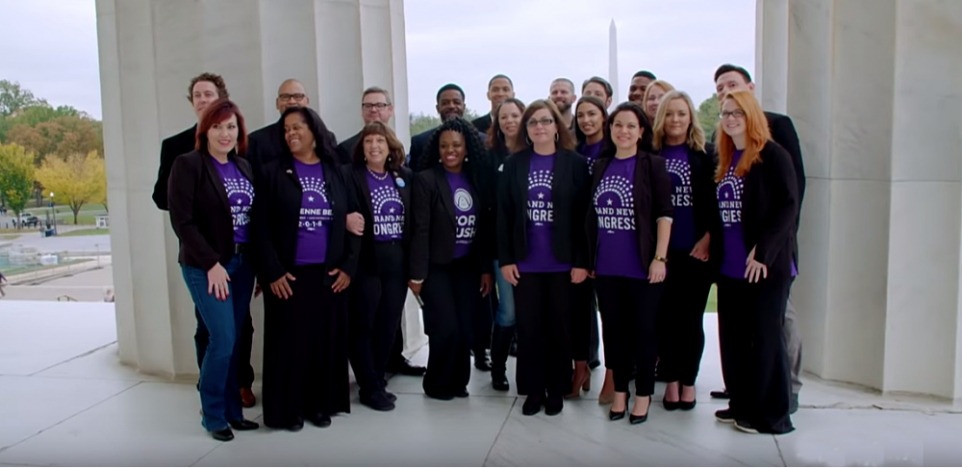
Knock Down the House is a documentary directed by Rachel Lears that follows four female Democrats, Alexandria Ocasio-Cortez of New York, Amy Vilela of Nevada, Cori Bush of Missouri, and Paula Jean Swearengin of West Virginia, who decided to run for Congress in the 2018 United States elections. While Vilela, Bush, and Swearengin lost in the primary round, Ocasio-Cortez won the election and today has become a major player in the Democratic party and the House of Representatives.
Vilela, Bush, Swearengin, and Ocasio-Cortez are candidates nominated by Brand New Congress, an organization focused on nominating non-career politicians to office and hoping to change the nation. They represent a movement that is spreading across the nation, women and non-career politicians running for the first time in hopes of making real change for their communities.
Knock Down the House starts with Ocasio-Cortez showing her struggle balancing waitressing while campaigning. We see her working, her lugging ice, but we also see her explaining why being part of the working class makes her more qualified than her opponent, she is on her feet 18 hours a day and she is used to people trying to make her feel bad.
Ocasio-Cortez makes a point in a small meeting with community members that her opponent raised three million dollars during the previous cycle from Wall Street donors alone. It creates an interesting dichotomy considering her campaign started with just two dollars and took no money from PACs, political action committees. But this story isn’t unique to Ocasio-Cortez, all of the women covered in Knock Down the House feel something similar. Their leadership has failed them and feeling like no one will help them and their community, they decide to do it themselves.
Knock Down the House shows not only how messy the political rhetoric can be, but also the actual process of getting on the ballot and organizing a campaign, something a lot of everyday Americans are often not aware of. Tricky laws, rules, and work around exist that make it exceeding difficult for candidates to challenge incumbents. Exposing these bring to light exactly how unjust our supposed democracy can be.
Although the documentary primarily follows Ocasio-Cortez, most likely since she is the only candidate that won her election. However, the most emotional and heartbreaking moments of the documentary come from the stories of Vilela, Bush, and Swearengin.

Vilela campaigns for healthcare for all and refuses to every compromise on it, having lost her daughter Amy when she was 22 who died after showing signs of a blood clot but was refused the testing she needed at an ER because she didn’t have proof on insurance. Bush, a registered nurse, fights for justice in her hometown which previously felt like a warzone after the tragic killing of Michael Brown, an unarmed Black man, who was shot by police. Swearengin, a coal miner’s daughter, speaks about the ongoing epidemic that West Virginia faces as more and more coal miners and communities breathe in deadly toxins caused by the mining.
As much as the moments following Vilela, Bush, and Swearengin are impactful and emotional, the moments following Ocasio-Cortez humanize her. Since her win, Ocasio-Cortez has become a media sensation for both the left and the right. It is often easy to forget she is human. In a scene where Ocasio-Cortez is prepping for her debate with Joseph Crowley, she waves her arms and chants “I need to take up space.”
This mantra is the exact opposite of what women have been told for centuries. It serves as a reminder that Ocasio-Cortez is just like every other woman in America, she feels the same insecurities we all do. It is also a reminder that she is an ordinary person who just happens to be doing extraordinary things.
Ocasio-Cortez’s win and many like it across the nation helped the Democrats take back the House in 2018. But the documentary is also a stark reminder just how many people remain in Congress who fuel the dangerous machine of industry and who do not necessarily have Americans best interest at heart.
Americans love a story about an underdog, it’s why stories like Rocky and Star Wars carry the cultural impact they do. But it is a lot scarier when you know what is at stake – in my case as a woman, as a Latina, as a disabled person, and as an American who loves her country.
In 2018, 125 women were elected to office. In the House of Representative alone 102 women were elected, 37 were women of color, the most ever. Leading Politico to call the 2018 election the ‘Year of the Woman’ and while the political climate of 2019 hardly feels kind to women, this documentary serves as a reminder that with every two steps forward, we take one back. When handing out fliers, Ocasio-Cortez tells her niece, “with every 10 rejections, you get once acceptance. And that’s how you win everything.”
Knock Down the House ends on a high note and despite the still turbulent climate of American politics, it acts as a solid reminder that often the greatest threat to American democracy is cynicism and apathy. Ocasio-Cortez’s win and successful uprooting of one of the most senior members of the Democratic party not only in Congress but in Queens shows there is hope and the power still lies in the people, it just takes a lot more time and effort.
Knock Down the House is now streaming on Netflix.
Knock Down the House
-
Knock Down the House - 9/109/10
TL;DR
Knock Down the House ends on a high note and despite the still turbulent climate of American politics, it acts as a solid reminder that often the greatest threat to American democracy is cynicism and apathy.




